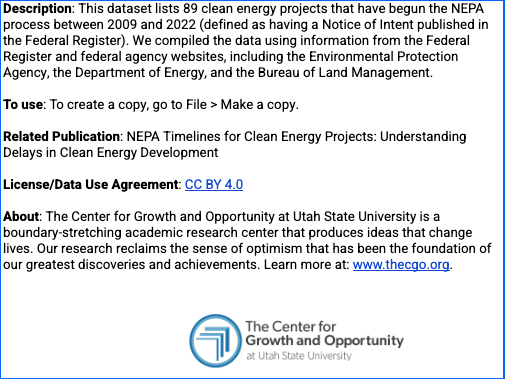Introduction
Below are charts summarizing key features of the process—average timelines and report lengths, broken down by energy type. We included nuclear, solar, wind, and hydroelectric projects in our analysis. Note that our database only includes projects that underwent the process of creating an Environmental Impact Statement (EIS), but does not include those that only completed an Environmental Assessment (EA).
Many more EAs are completed each year than EISs. However, EISs are longer and more comprehensive reports, contributing significantly to the time it takes to complete the NEPA process. We plan to continue building the dataset, adding more years and expanding it to include clean energy projects that require an EA.
Average EIS Length
There is no length requirement for EISs, but their length has grown over time, with an average of over 1,000 pages. The report includes information about the current status of the environment where the project would be located, expected impacts on that environment, possible and proposed alternatives to the project under consideration, and information and analysis submitted by state, tribal, and local governments and public commenters.
Solar and wind energy projects have the longest Environmental Impact Statements while hydroelectric and nuclear projects tend to have the shortest impact statements.
Average and Median Timelines for each NEPA “Milestone”
The NEPA process includes several stages. First, a Notice of Intent is published, indicating that an agency intends to prepare an Environmental Impact Statement (EIS), a document that evaluates in-depth the expected environmental impacts of a project or regulation. The second stage is to prepare a draft EIS (DEIS), which is made public for comment and suggestions; the leading agency will then implement some points of recommended change to complete the Final EIS (FEIS). Lastly, project approval decisions are published in the government’s Record of Decision (ROD). The availability of the DEIS, FEIS, and the ROD are made known in the Federal Register.
In the following section, we have outlined the average and median lengths of time that it takes for clean-energy projects to complete each milestone and the entirety of the approval process. We also break it down by specific energy types.
Number of Notices of Intent Released per Year
This graph shows how many Notices of Intent to prepare an EIS were published each year. This is a measure of how many new clean energy projects begin the full NEPA process each year. However, many more clean energy projects undergo the more limited Environmental Assessment process each year.
Average and Median Timeline for NEPA Completion (NOI to ROD) for All Clean-Energy Projects
This chart shows the average timeline for a project to complete all the reporting requirements of the NEPA process. Once the FEIS is complete, the agency can begin the process of determining approval. Solar projects have the shortest timelines on average, at just under two years from the NOI to publication of the FEIS.
This chart shows the timeline for a project to complete the entire NEPA process. The average timeline across all energy types is approximately three years, excluding projects that have yet to be completed.
NEPA Timeline and New Projects by Energy Type
Nuclear
Nuclear projects tend to take longer to complete the draft and final EIS reports than wind and solar projects, but once an FEIS is complete, they are quicker to approve than other project types. Of the nuclear projects that have reached an ROD, the lengthiest time for a project to complete the NEPA process was 7.8 years.
Note that the median length of time to finish the FEIS is longer than the time taken to release the Record of Decision. This is because just over 50 percent of the nuclear projects have RODs. Because only half the projects have completed the NEPA process, the data is incomplete and the average timeline from NOI to ROD appears shorter than it truly is.
During several years, no nuclear projects began the process of drafting an EIS. There were no new projects between 2013–18, and none in 2022.
Solar
Solar projects have the shortest average time to complete the NEPA process. It takes on average just three months to release a Record of Decision after completing the FEIS. Of the solar projects that have reached an ROD, the lengthiest time for a project to complete the NEPA process was 8.9 years. The shortest timeline for a solar project to reach an ROD was 336 days.
There are more solar projects in the dataset than any other energy type, with the highest activity years occurring pre-2012. Similar to other energy types, fewer solar projects were required to draft an EIS between 2013-2017.
Wind
For wind projects, there is a relatively large gap between the average and median time lengths to release an ROD after the FEIS has been published, but both take less than half a year. The longest NEPA timeline for a wind project was 11.3 years for the contested Cape Wind project, while the shortest was 323 days.
Wind projects are the second most common energy source in the dataset. There was also a dip in new wind projects required to draft an EIS from roughly 2013–2017.
Hydroelectric
Hydroelectric projects take the longest amount of time to complete the draft EIS of any clean energy projects, despite having the shortest report lengths. The longest timeline for a hydroelectric project to reach an ROD was 9.8 years, while the shortest was 2.5 years.
New hydroelectric comments began the NEPA process at a steady rate compared to the other energy types. However, no new hydroelectric projects have been required to complete an EIS for the last four years. There are multiple new hydroelectric projects that began the less intensive Environmental Assessment report during the last four years, but they are not included in the dataset.
Methodology
We manually gathered data on clean energy projects across five energy types: wind, solar, nuclear, hydroelectric, and geothermal. Geothermal projects were excluded from the charts because there were too few to calculate meaningful statistics, but are included in the full dataset. We focused mainly on new generation facilities, although some non-generation projects that are directly related to clean energy development and operation were included. The dataset includes new license applications, but not license renewals for existing projects. In future updates, we plan to gather data for additional years, add transmission and other related projects, and may expand the dataset to include Environmental Assessments.
Dataset
You can view the full dataset below or click here to create your own copy.



